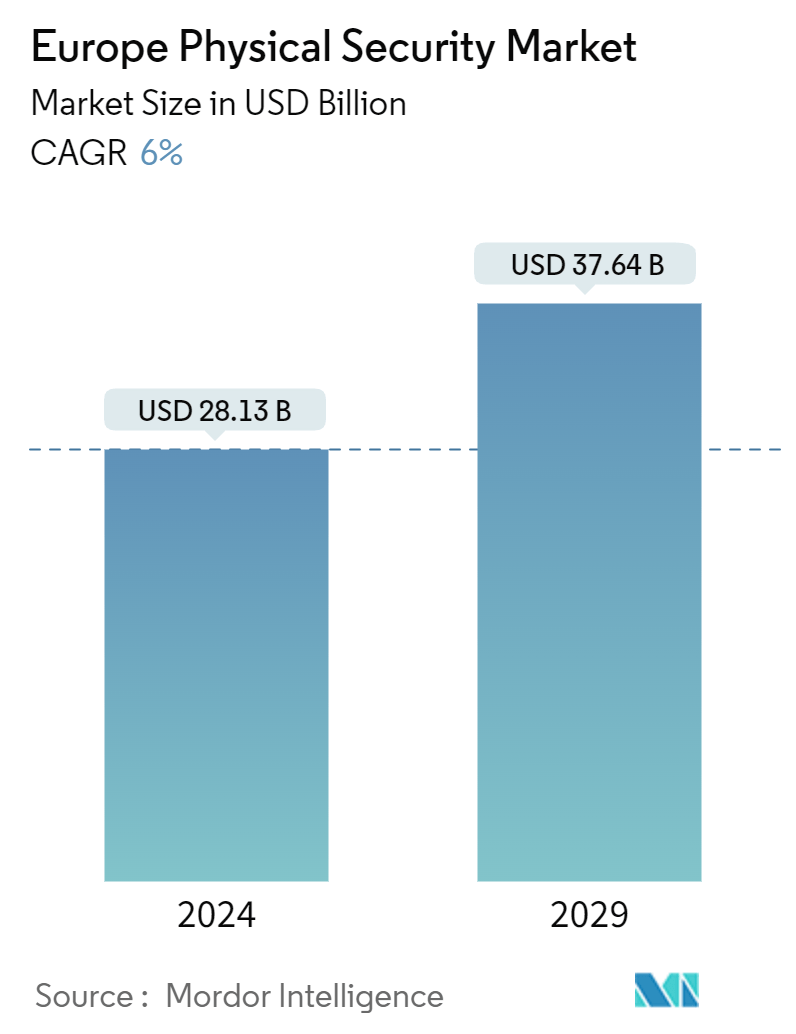Market Size of Europe Physical Security Industry

| Study Period | 2019 - 2029 |
| Base Year For Estimation | 2023 |
| Market Size (2024) | USD 28.13 Billion |
| Market Size (2029) | USD 37.64 Billion |
| CAGR (2024 - 2029) | 6.00 % |
| Market Concentration | Low |
Major Players
*Disclaimer: Major Players sorted in no particular order |
Europe Physical Security Market Analysis
The Europe Physical Security Market size is estimated at USD 28.13 billion in 2024, and is expected to reach USD 37.64 billion by 2029, growing at a CAGR of 6% during the forecast period (2024-2029).
- Physical security encompasses many aspects that must be addressed to guarantee an organization's safety. At its most fundamental, physical security encompasses security measures directly related to safeguarding individuals, assets, and infrastructure. Physical security systems like video surveillance cameras and cloud-based surveillance have significantly contributed to the European market's growth. The market is witnessing an increasing number of security cameras.
- The rapid advancements of artificial intelligence (AI) and machine learning (ML), incorporated into smart building technology in new construction and commercial refurbishment, have resulted in an increasing number of devices utilizing physical security systems. These factors, combined with the ever-evolving nature of cloud storage for many applications, necessitate architecture and technology updates that drive the growth of physical security systems.
- The physical security market's growth is augmented by integrating these systems with Internet of Things (IoT) devices, artificial intelligence, and cloud services. For instance, in August 2023, an artificial intelligence (AI) camera system was installed along a major road in England, United Kingdom, by the police. Within 72 hours, the system had captured nearly 300 drivers in breach of the law. After five days, the number had increased to a total of 1,000. The government is adopting such security measures to avoid accidents and enforce the rules and regulations better. AI-powered cameras have seen a rapid increase in demand and will likely boost the market's growth.
- Implementing advanced video analytics offers a wide range of capabilities, such as iris, fingerprint, facial, license plate recognition, crowd recognition, and tracking and counting people, driving the need for physical security solutions. In Germany, biometrics are being increasingly used in retail and hospitality settings to automate age estimation, payment processes, and more. Such adoption will generate more demand for physical systems across Germany.
- After the COVID-19 pandemic, the European market increased physical security business opportunities, with the potential to purchase more advanced products and systems. The physical security market is experiencing a steady increase in size and the adoption of security devices. Additionally, businesses and public areas have had to keep up with changing health requirements. Therefore, physical security systems now enable compliance with capacity restrictions, mask compliance, and hygiene regulations.
- However, organizations across Europe face significant challenges when implementing surveillance and analytics systems, as they are subject to operational issues, and accuracy is one of the primary barriers to adoption. Furthermore, video surveillance has become a contentious issue in the civil liberties community, as it is seen as a breach of privacy. There is a growing awareness of who is watching the video and the potential for misuse, as individuals anticipate that their data will only be used for legitimate and specified purposes, thus hindering the market's growth.
Europe Physical Security Industry Segmentation
Physical security refers to preventing unauthorized intruders from accessing controlled facilities. Physical security technologies have developed significantly recently, offering advanced protection at competitive prices. Physical security devices utilize cloud technology and AI for even more sophisticated real-time data processing. Various automated physical security components can perform multiple functions in a physical security system.
The European physical security market is segmented by system type (video surveillance system [IP surveillance, analog surveillance, and hybrid surveillance], physical access control system (PACS), biometric system, perimeter security, and intrusion detection), service type (Access Control-as-a-Service (ACaaS) and Video Surveillance-as-a-Service (VSaaS)), type of deployment (on-premises and cloud), organization size (SMEs and large enterprises), end-user industry (government services, banking and financial services, IT and telecommunications, transportation and logistics, retail, healthcare, residential, and other end-user industries), and country (the United Kingdom, Germany, France, and Rest of Europe). The report offers the market sizes and forecasts for all the above segments in terms of value (USD).
| By System Type | |||||
| |||||
| Physical Access Control System (PACS) | |||||
| Biometric System | |||||
| Perimeter Security | |||||
| Intrusion Detection |
| By Service Type | |
| Access Control as a Service (ACaaS) | |
| Video Surveillance as a Service (VSaaS) |
| By Type of Deployment | |
| On-Premises | |
| Cloud |
| By Organization Size | |
| SMEs | |
| Large Enterprises |
| By End-user Industry | |
| Government Services | |
| Banking and Financial Services | |
| IT and Telecommunications | |
| Transportation and Logistics | |
| Retail | |
| Healthcare | |
| Residential | |
| Other End-user Industries |
| By Country*** | |
| United Kingdom | |
| Germany | |
| France | |
| Spain | |
| Italy |
Europe Physical Security Market Size Summary
The European physical security market is experiencing significant growth, driven by the increasing need to safeguard individuals, assets, and infrastructure. This growth is fueled by advancements in technology, such as artificial intelligence, machine learning, and the Internet of Things, which are being integrated into physical security systems like video surveillance and biometrics. These technologies are enhancing the capabilities of security systems, making them more efficient and effective in addressing security challenges. The market is also witnessing a rise in the adoption of cloud-based surveillance solutions, which are becoming increasingly popular due to their flexibility and scalability. The demand for advanced security measures is further propelled by the need to comply with health regulations and ensure safety in public and private spaces, especially in the aftermath of the COVID-19 pandemic.
The market landscape is characterized by a fragmented structure with numerous players engaging in strategies such as product innovation, partnerships, and mergers to strengthen their market position. Companies like Siemens AG, Securitas AB, and Bosch Security Systems GmbH are at the forefront, offering a range of security solutions tailored to meet the evolving needs of the European market. The integration of biometrics in various sectors, including retail, hospitality, and transportation, is also contributing to market expansion. Despite the growth prospects, challenges such as privacy concerns and the need for accurate surveillance systems remain significant barriers. However, the ongoing technological advancements and increasing demand for secure environments are expected to drive the market's growth trajectory in the coming years.
Europe Physical Security Market Size - Table of Contents
-
1. MARKET INSIGHTS
-
1.1 Market Overview
-
1.2 Industry Attractiveness - Porter's Five Forces Analysis
-
1.2.1 Bargaining Power of Suppliers
-
1.2.2 Bargaining Power of Consumers
-
1.2.3 Threat of New Entrants
-
1.2.4 Threat of Substitutes
-
1.2.5 Intensity of Competitive Rivalry
-
-
1.3 Impact of COVID-19 Aftereffects and Other Macroeconomic Factors on the Market
-
-
2. MARKET SEGMENTATION
-
2.1 By System Type
-
2.1.1 Video Surveillance System
-
2.1.1.1 IP Surveillance
-
2.1.1.2 Analog Surveillance
-
2.1.1.3 Hybrid Surveillance
-
-
2.1.2 Physical Access Control System (PACS)
-
2.1.3 Biometric System
-
2.1.4 Perimeter Security
-
2.1.5 Intrusion Detection
-
-
2.2 By Service Type
-
2.2.1 Access Control as a Service (ACaaS)
-
2.2.2 Video Surveillance as a Service (VSaaS)
-
-
2.3 By Type of Deployment
-
2.3.1 On-Premises
-
2.3.2 Cloud
-
-
2.4 By Organization Size
-
2.4.1 SMEs
-
2.4.2 Large Enterprises
-
-
2.5 By End-user Industry
-
2.5.1 Government Services
-
2.5.2 Banking and Financial Services
-
2.5.3 IT and Telecommunications
-
2.5.4 Transportation and Logistics
-
2.5.5 Retail
-
2.5.6 Healthcare
-
2.5.7 Residential
-
2.5.8 Other End-user Industries
-
-
2.6 By Country***
-
2.6.1 United Kingdom
-
2.6.2 Germany
-
2.6.3 France
-
2.6.4 Spain
-
2.6.5 Italy
-
-
Europe Physical Security Market Size FAQs
How big is the Europe Physical Security Market?
The Europe Physical Security Market size is expected to reach USD 28.13 billion in 2024 and grow at a CAGR of 6% to reach USD 37.64 billion by 2029.
What is the current Europe Physical Security Market size?
In 2024, the Europe Physical Security Market size is expected to reach USD 28.13 billion.

